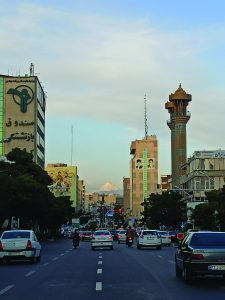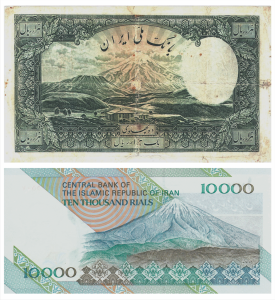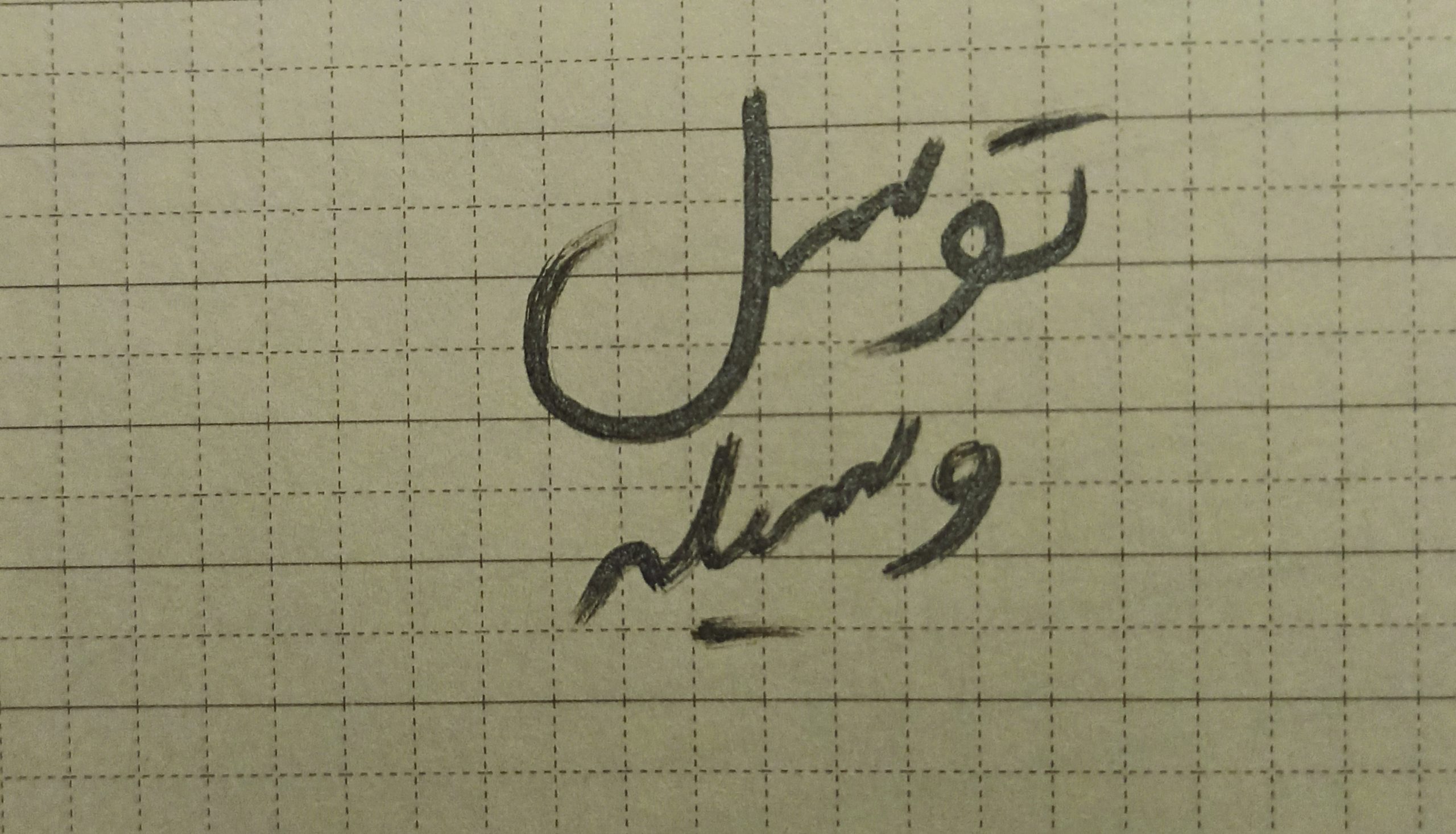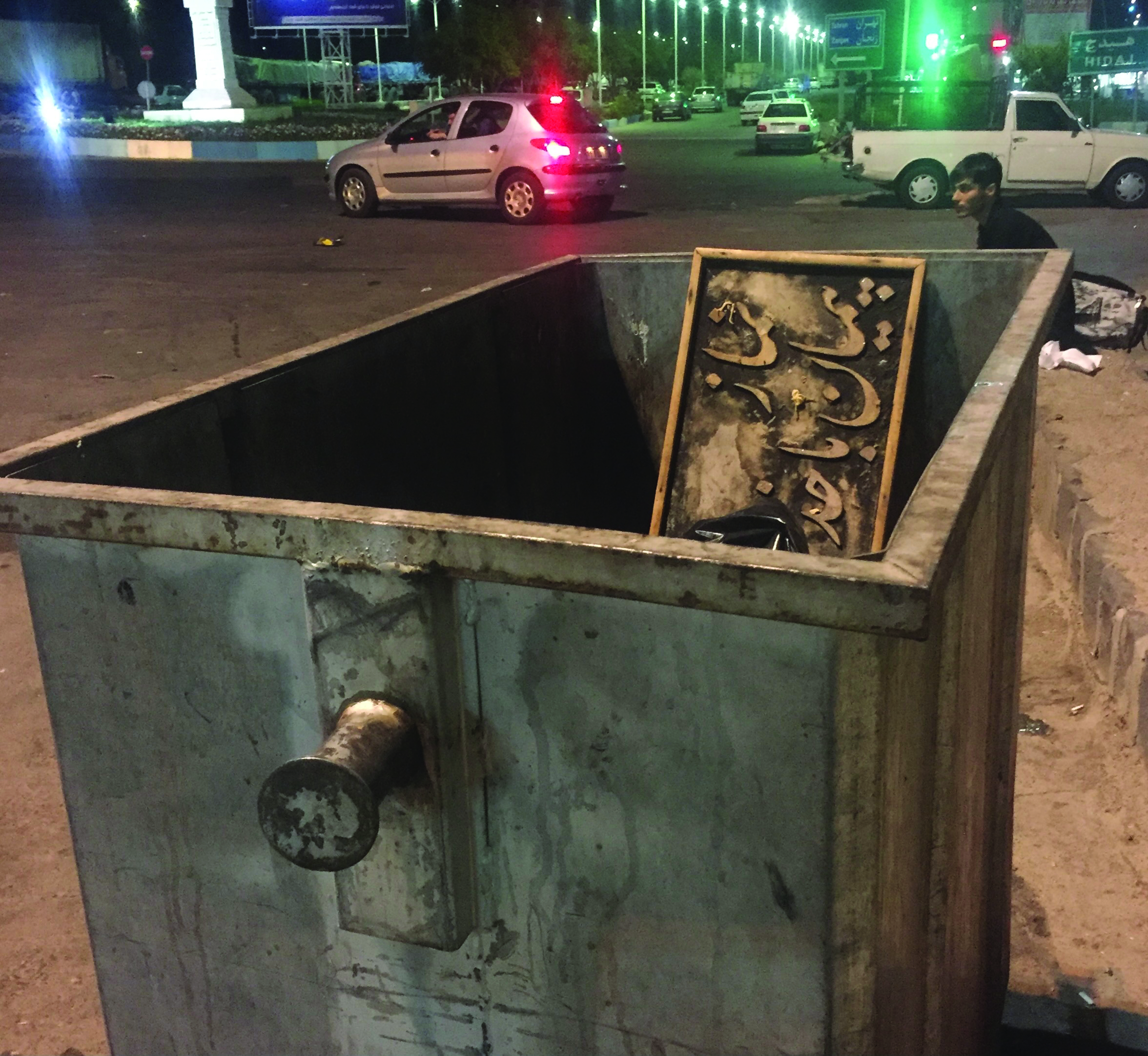Prelude
Today in Tehran, the traces of the past and the thirst for running towards the future are intertwined in such a way that we have lost the ability to speak about the coordinates of our consciousness. By ‘speaking’, I mean the retelling of the story that the city expresses through architecture. To have a stuttering tongue does not point to our muteness; exactly at the point that we fall silent, the city starts to speak, breaking the silence in a language of fragmented and incongruous alphabets that constructs its words with letters from a multitude of tongues.
The Alborz mountain range and its majestic peak, Mount Damavand, or in the words of the poet, Malek osh-Sho’arā Bahār (1886-1952) in his poem, The Chained White Beast, Damavandiyeh (The Dome of the Universe) is the city’s only true compass.1 The experience of life in the city of Tehran highlights, evermore, the special place that Damavand has in Persian mythology. It is in reference to it that we can still locate our place, despite being lost in this speed. In the background of the city’s image, and amidst its bizarre transformations and constant metamorphoses, Mount Damavand reminds us powerfully of where we stand whilst the foreground image’s exponential growth contends to erase the image of that sleeping volcano.
The poet Bahār, writes, in the same poem:

You are the lethargic heart of the earth
inflamed from pain
covered with camphor balm
to calm bruise and pain
Explode, thou heart of the times
and do not choose to hide your inner fire


“Explode, thou heart of the times” is an exhortation for the sleeping volcano’s eruption: an intervention that the poet asks of Damavand in this urgent situation, exactly one hundred years ago. Bahār asks Damavand to impregnate the clouds and bring down the rains, while in another line he begs it to burn everything down with the fire of its rage.
And today, much like a century ago, the world that surrounds Damavand is still trapped in a state of emergency, and it is this enormous, live mountain that ultimately determines the spiritual geography of its location: the need to refer to its power and beauty, more undeniable than ever, rises before our eyes every morning before the avalanche of smoke and dust makes it disappear.
An emergency is a situation that invites the alert mind to intervene. Like a healthy and conscious mind that belongs to the fragmented, torn and tired body of this city, Damavand, alive and aware, understands all that is going on in the city’s body: how it denies the emergency at hand with an obsessive fervor, pushing reality to the margins in favour of a theatrical charade of order that is in fact founded on anarchy.
I invite you towards the coming lines that lay ahead, not from the point of view of a writer, but that of an installation artist who builds spaces with words. I will let you wander amongst the things that I find myself wandering amidst: in the space of in-betweens, somewhere between reality and truth, between being the narrator and the narrative, between being the object and the subject, between seeing and being seen, between imagination and fact, between our truth and post-truth.
Interlude
I burned it,
since building is in burning.
I destroyed it since construction is in destruction.
Shams-i Tabrīzī2
Site/Body
Crime scene detectives believe that the body of the murdered speaks to us silently, recounting the entire story of the murder. I believe that places, much like the corpses of murdered bodies, can tell us about the coordinates of a culture, its political and social conditions—in short, all that happens in that place. My aim in writing this piece is to translate the story that this architecture is telling and to place it in the context of this essay. I intend to rebuild and move this body, which I see as the body of society, in order for the reader to access it and to observe and decode it. The space that I recreate here, is indeed a synthesis of my simultaneous observations and interpretations: a “second edition” coupled with a narrative and at times with emphasis on the parts that can convey important information about this body to the reader, much like the spotlight that shines on the main character on a theatre set.
Observation/Encounter
‘Observation’ is the starting point of every piece that I make; and then ‘writing’ which fills the distance between ‘seeing’ and ‘revealing’ of things. Words make it possible for me to redefine phenomena in a relatively far distance from ‘what the other sees’.

Writing, in my work, is the first step in defamiliarising of phenomena: the first step on the difficult path of revealing ‘what I see.’ In a way one can say that what you are reading is not a reportage, but the result of an encounter. In my view, this work is a non-physical installation in a different context. My approach in the organising and processing of this text and its illustrations before you is the same as my approach in creating installations in the white cube of a gallery or any other space.
Location/Situation
In the city, objects pile up and then sediment, and their dregs flow to the margins. I write: ‘dregs,’ I read: ‘essence’; much like the people whom in the present world resemble mere numbers. All the materials for the construction of a space are available here in the outskirts of the city. The city is constantly dredging, like the flow of a river that moves the garbage to its banks and continues to flow freely on its bed. But to understand what is happening to the river one has to look at its banks, and to understand the sea one has to step on its shores.
The abandoned brick kilns in the eastern margins of Tehran were home to a small community of people who have had to move to the outskirts of Tehran to work at these factories. Today, after 20 years most of the kilns have shut down and the better part of the families work in other factories or make ends meet by recycling garbage or construction waste. A hosseiniyeh is built in this neighbourhood voluntarily by the members of the community. Hosseiniyeh is a building type for the performance of religious ceremonies and is supposed to be a place for tavasol, which means to appeal and is derived from the word vasileh which means instrument. The Prayer of Tavasol is one of the most important group ceremonies that happens in a hosseiniyeh. It is a plea to the instruments of closeness to god. Here, instrument suggests something more than a thing or a tool, it is a cause. In this setting, the hosseiniyeh is the meeting place and appeal is the intention. The difference between this hosseiniyeh and any other architecture is in that it conflates the image and the meaning of its geography.

Territory/Sanctuary
The most common building material in this neighbourhood and in most other slum dwellings is construction waste. One can see a slew of these heterogenous leftovers used as building parts in slums; for example, doors discovered as found objects amidst construction waste or purchased from demolition workers.

The intriguing ceiling of the main space of the hosseiniyeh is made from the assemblage of these doors: each door is a door that once opened to a home or a room; a door that might have belonged to a child’s room in a tiny apartment where the child marked his/her territory by placing a cartoon sticker on it; a door that recounts the architectural style of Tehran in the 1960s or 1970s; an ideal door to a courtyard veranda in the heart of Tehran of those years. But whose territory do these doors presently mark? Or to which neighbourhood, which space do they open? Changing their function from door to ceiling in this striking installation is perhaps a simultaneous grimace at and praise of poverty. How naïve it is to close our eyes in a fraction of a second on this reality that they only shelter the hosseiniyeh from wind and rain; to think that they now open to the sky and heavens above. The absence of the doors’ original contexts is less a reminder of their torn from their previous places than it is a form of denial of a perfectly incongruous order, as if this strange city that does not know the taste of its own mouth, swallows everything and continuously throws up the contents of its own belly.
Order/Border
In the paintings discovered from Paleolithic cave dwellers, we can clearly see the realistic approach of primitive humans in the accurate representation of the animals’ reality. They have only observed and painted aspects essential to expressing the appearance and the soul of the outer and inner world of the animals: their beauty, ugliness, agility, grace, and savagery. These paintings often appeared in the inner depth of the caves, signifying the fact that these were not decorative paintings, but considered to have magical powers. They were drawn in order to dominate the soul of the animal and to bind it to a limited frame—that of their own hunting territory.
The repeated exercise of drawing the hunt and the remembrance of all the details to achieve dominance over the body of the hunt is similar to how the margin-dwellers deal with construction waste that is brought in from the city centre. As if in this migrant colony, each member of the society, unknowingly, takes a stab at conquering the souls of the city’s structures through this change in the of function and pastiche of these objects: to redefine the meaning of house, hosseiniyeh, or an apartment.
As if with the reuse of these objects, these inhabitants get one step closer to conquering the task of owning that which they desire. As if by mimicking the movements of their hunt, and by placing together the dismembered parts of several bodies in a new composition, they manage to create anew a whole body.

This body is evocative of any building that the city accepts within itself. And it is in this way that the migrants within the margins practice house, hosseiniyeh, and ultimately the city. But in this way, they have conquered and possessed the soul of every house, every hosseiniyeh, not knowing they have transplanted the heart of the city to its margins and have crafted a new spiritual climate outside the boundaries of the city’s relationship with government: abandoned, discarded, apparently separate from the city, but in reality, woven into its roots.
Inner/Outer
The main space of the hosseiniyeh is where an installation of doors comprises the ceiling, while the floor is adorned with a multitude of Persian carpets, some overlapping on the edges in order to completely cover the floor. The walls are all covered with brocade banners and standards in green, gold, and red hues. On the main stage of the hosseiniyeh there is a podium for the orator which is in fact just an armchair next to a microphone and a loudspeaker. The armchair, much like the door, is a recurring typology in migrant colonies. The hosseiniyeh is located between two corridors: one leading to the shabestan, (a prayer hall in a mosque deriving its name from shab or night, signifying women’s quarters), and the other, a passageway to the common courtyard of the slum houses. Here, the shabestan is the women’s hall and it is comprised of an empty room with a few mats on the floor, blotchy walls, and a lone speaker that echoes the voice of the male orator in the main hall.
This speaker, adorned with a flag, is the only defining characteristic of this empty and cold space, highlighting it from any other space and signifying its function. Now if we consider the shabestan as the andarooni (the private quarters of historic houses in Iran, often the territory of women), and the main space with the orator as the birooni (the public quarters of historic houses in Iran, often the domain of men), we can clearly see that the ‘speaker’ is male and the ‘listener’ is female. In other words, that men gain their credibility through speaking, and women, through listening. These two spaces, juxtaposed together, delicately expose the reality of a cultural space. This installation is not an interpretation, but a perfect translation of a cultural pattern, with all its physical insignia and non-physical qualities that make it possible to experience the heart of the city within the peripheries; here, itself regenerating an order.
Edge/Threshold
The common denominator between the doors and the inhabitants of brickyards is that they are both products of the urban outflow. This outflow creates an atmosphere that leaves me on a threshold: the threshold of simultaneously experiencing a truth from the inside while watching it from the outside; that the truth of a city manifests itself on its edges, and that to witness that truth we have to distance ourselves from the city as far as where the waves wash whatever is not of the sea and surrender them to the shore. And that the shore is the sea’s memory with all of its waste and its together in an out-of-tune symphony.


